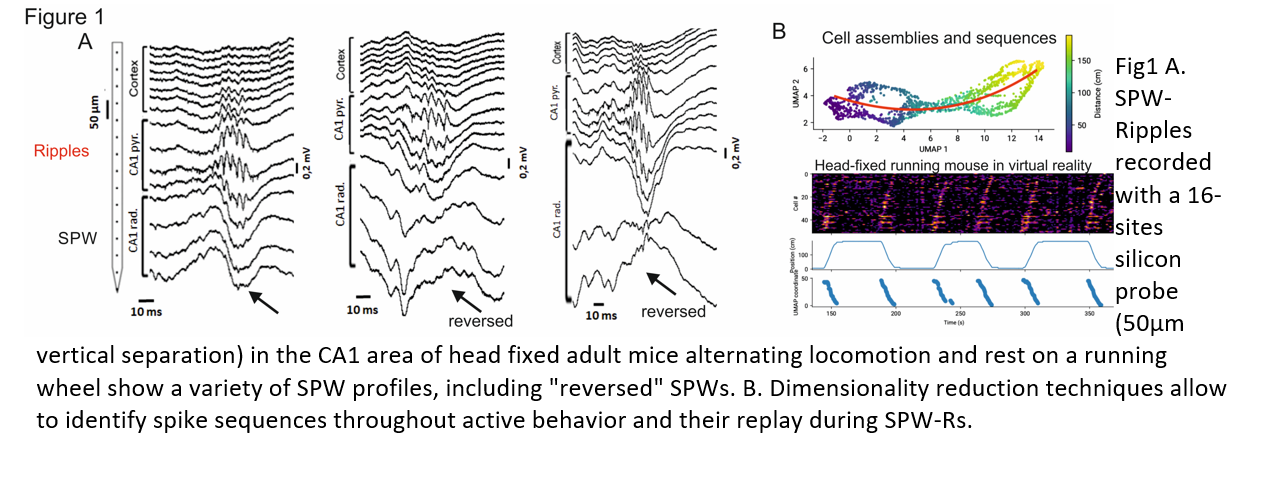PHD2024-23
Unveiling the functional diversity of hippocampal fast oscillations for memory processing
Host laboratory and collaborators
Xavier Leinekugel, INMED xavier.leinekugel@univ-amu.fr
Hervé Rouault, CPT herve.rouault@univ-amu.fr
Abstract
The hippocampal region plays a pivotal role in episodic memory formation through orchestrated neuronal discharges organized as cell assemblies or hippocampal Sharp Wave Ripples (SPW-Rs). Our recent experimental observations reveal distinct profiles of SPW-Rs, suggesting the involvement of distinct neuronal subcircuits, which was not considered until now. Our hypothesis posits the existence of various SPW-R classes, each representing unique neuronal networks and functional processes. To investigate this, we propose to employ advanced signal processing techniques, leveraging recent machine learning innovations such as attentional networks and non-linear dimensionality reduction. This approach aims to demonstrate the previously overlooked diversity of SPW-Rs in terms of electrographic signatures and their association with participating neural circuits.
Keywords
Memory, neural processing, signal analysis, machine learning, classifiers, hippocampal circuitry
Objectives
This project seeks to develop a classification framework based on attentional networks for SPW-Rs, challenging and expanding our understanding of hippocampal neural circuit processing. Contrary to the conventional view, our observation of diversity in the electrographic signatures of CA1 ripples suggest the local integrative processing of distinct sets of inputs. Through cutting-edge analysis techniques, we aim to elucidate the significance of the previously overlooked diversity of SPW-Rs.
Proposed approach (experimental / theoretical / computational)
This project combines computational and experimental approaches. Simultaneous recordings from Entorhinal Cortex, CA3 and CA1 hippocampal regions performed in adult mice during rest and wheel running in the head-fixed configuration (multisite silicon probes and spike sorting analysis to reach single cell resolution) will be analyzed using machine learning techniques, such as variational autoencoders (VAEs) with transformers networks, to classify experimentally recorded CA1 SPW-Rs based on their electrographic signature. Subsequently, non-linear dimensionality reduction techniques like UMAP will be applied to analyze cell assemblies and sequences associated with CA1 SPW-Rs. This will enable the identification of distinct cell assemblies preferentially linked with specific SPW-R profiles, providing insights into the functional segregation of hippocampal processing during SPW-Rs.
Interdisciplinarity
This project represents a unique blend of interdisciplinary collaboration, merging the conceptual and experimental proficiency of X. Leinekugel in neuroscience with the theoretical and computational expertise in neural networks and information processing contributed by Hervé Rouault. By harnessing the synergy between these domains, we aim to advance our understanding of the neural mechanisms underpinning episodic memory in the mammalian . Computational approaches, driven by the rapid evolution of computing power, opens new avenues to address fundamental questions in neuroscience. Leveraging machine learning classifier algorithms and non-linear dimensionality reduction techniques, this project pioneers an interdisciplinary approach to unravel the intricacies of neural processing during episodic memory formation.
Expected profile
We seek a highly motivated PhD student with a robust background in physics and/or computational approaches, particularly in signal analysis and machine learning. Prior experience with experimental electrophysiological recording analysis can be appreciated, but is not mandatory. The ideal candidate should demonstrate a keen interest in probing fundamental questions within the field of neuroscience and possess a curiosity-driven approach to interdisciplinary research. This position offers a unique opportunity for the selected candidate to bridge the gap between theoretical insights and experimental observations, contributing to groundbreaking discoveries in the realm of neural circuit processing and memory formation.
Is this project the continuation of an existing project or an entirely new one? In the case of an existing project, please explain the links between the two projects
This project is an entirely new project, although based on experimental observations made in former experimental projects.
2 to 5 references related to the project
- Buzsáki, G. (2015). Hippocampal sharp wave-ripple: A cognitive biomarker for episodic memory and planning. Hippocampus 25, 1073-1188.
- Gedankien, T., Gotman, J., et al. (2022). A consensus statement on detection of hippocampal sharp wave ripples and differentiation from other fast oscillations. Nat Commun 13, 6000.
- Girardeau, G., Benchenane, K., Wiener, S.I., Buzsaki, G., and Zugaro, M.B. (2009). Selective suppression of hippocampal ripples impairs spatial memory. Nature Neuroscience 12, 1222-1223.
- Valeeva, G., Janackova, S., Nasretdinov, A., Rychkova, V., Makarov, R., Holmes, G.L., Khazipov, R., and Lenck-Santini, P.-P. (2018). Emergence of Coordinated Activity in the Developing Entorhinal–Hippocampal Network. Cerebral Cortex 29, 906-920.
- Vaswani, A., Shazeer, N., Parmar, N., Uszkoreit, J., Jones, L., Gomez, A. N., ... & Polosukhin, I. (2017). Attention is all you need. Advances in neural information processing systems, 30.
Two main publications from each PI over the last 5 years
X. Leinekuegel
- Dubanet, O., Ferreira Gomes Da Silva, A., Frick, A., Hirase, H., Beyeler, A., and Leinekugel, X. (2021). Probing the polarity of spontaneous perisomatic GABAergic synaptic transmission in the mouse CA3 circuit in vivo. Cell reports 36.
- Carreño-Muñoz, M.I., Medrano, M.C., Ferreira Gomes Da Silva, A., Gestreau, C., Menuet, C., Leinekugel, T., Bompart, M., Martins, F., Subashi, E., Aby, F., et al. (2022). Detecting fine and elaborate movements with piezo sensors provides non-invasive access to overlooked behavioral components. Neuropsychopharmacology 47, 933-943.
H. Rouault
- Dard RF, Leprince E, Denis J, Rao Balappa S, Suchkov D, Boyce R, Lopez C, Giorgi-Kurz M, Szwagier T, Dumont T, Rouault H, Minlebaev M, Baude A, Cossart R, Picardo MA. (2022). The rapid developmental rise of somatic inhibition disengages hippocampal dynamics from self-motion. Elife 11:e78116
- Kim SS, Rouault H, Druckmann S, Jayaraman V. (2017). Ring attractor dynamics in the Drosophila central brain. Science 356(6340):849-853
Project's illustrating image

